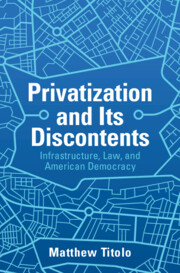Book contents
- Privatization and Its Discontents
- Privatization and Its Discontents
- Copyright page
- Dedication
- Contents
- Acknowledgments
- Introduction
- 1 Early Liberalism, Adam Smith, and the Seeds of the Infrastructural State
- 2 Forging the Infrastructural State
- 3 “A Wilderness of Turnpike Gates”
- 4 The Panic of 1837 and the Infrastructure Crash
- 5 “The Ground under Our Feet”
- 6 The Death of Laissez-Faire and the Rise of Infrastructure in the Cold War
- Conclusion
- Index
4 - The Panic of 1837 and the Infrastructure Crash
Published online by Cambridge University Press: 08 June 2023
- Privatization and Its Discontents
- Privatization and Its Discontents
- Copyright page
- Dedication
- Contents
- Acknowledgments
- Introduction
- 1 Early Liberalism, Adam Smith, and the Seeds of the Infrastructural State
- 2 Forging the Infrastructural State
- 3 “A Wilderness of Turnpike Gates”
- 4 The Panic of 1837 and the Infrastructure Crash
- 5 “The Ground under Our Feet”
- 6 The Death of Laissez-Faire and the Rise of Infrastructure in the Cold War
- Conclusion
- Index
Summary
In the 1820s and 1830s, state governments acted decisively in the face of federal paralysis to build their own transportation and communication networks. Because they possessed legal and political sovereignty, states could create the institutional blueprints for development by legislative fiat, capitalizing on their unique charter powers to establish a financial-infrastructure complex whose reach extended to global capital markets. Moreover, infrastructure promised to underwrite the political dream of a world without taxes. After all, if infrastructure could be debt financed with little up-front cost and creditors paid from the proceeds, then unpopular property taxes might be avoided altogether. But the debt-fueled infrastructure plan was precarious; the debt-fueled infrastructure boom of the 1830s precipitated a financial panic in 1837. Although the flow of credit resumed soon after the Panic, there was soon a wave of sovereign debt defaults and several outright repudiations. This led to legal reforms at the state level meant to curtail government involvement in infrastructure. For several decades, state courts were left to sort out the appropriate scope of public action in the infrastructure field by deciding whether governments were taxing for a truly “public purpose” when they invested in for-profit infrastructure ventures.
Keywords
- Type
- Chapter
- Information
- Privatization and Its DiscontentsInfrastructure, Law, and American Democracy, pp. 111 - 133Publisher: Cambridge University PressPrint publication year: 2023

